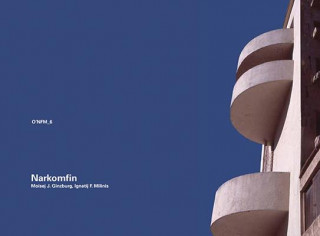
Kód: 02924225
Moisej J. Ginzburg, Ignatij F. Milinis: Narkomfin, Moscow 1892-1946
Autor Danilo Udovicki-Selb
Der sechste Band der O'Neil Ford Monograph-Reihe, herausgegeben vom Center for American Architecture and Design (CAAD) und dem O'Neil Ford Chair in Architecture an der University of Texas at Austin. Jede dieser Monografien in engl ... celý popis
- Jazyk:
 Angličtina
Angličtina - Vazba: Brožovaná
- Počet stran: 192
Nakladatelství: Wasmuth, 2016
- Více informací o knize

1134 Kč

Skladem u dodavatele v malém množství
Odesíláme za 10-14 dnů
Potřebujete více kusů?Máte-li zájem o více kusů, prověřte, prosím, nejprve dostupnost titulu na naši zákaznické podpoře.
Přidat mezi přání
Mohlo by se vám také líbit
-

Diamond Deception
719 Kč -

Homicide in American Fiction, 1798-1860
682 Kč
Dárkový poukaz: Radost zaručena
- Darujte poukaz v libovolné hodnotě a my se postaráme o zbytek.
- Poukaz se vztahuje na celou naši nabídku.
- Elektronický poukaz vytisknete z e-mailu a můžete ihned darovat.
- Platnost poukazu je 12 měsíců od data vystavení.
Více informací o knize Moisej J. Ginzburg, Ignatij F. Milinis: Narkomfin, Moscow 1892-1946
Nákupem získáte 113 bodů
 Anotace knihy
Anotace knihy
Der sechste Band der O'Neil Ford Monograph-Reihe, herausgegeben vom Center for American Architecture and Design (CAAD) und dem O'Neil Ford Chair in Architecture an der University of Texas at Austin. Jede dieser Monografien in englischer Sprache analysiert ein wichtiges Bauwerk moderner Architektur in fundierten Essays und an Hand von zahlreichen Fotos, Originalskizzen und Plänen. Die schön aufgemachten Bände ermöglichen so dem Leser ein ausgesprochen detailliertes Studium ausgesuchter architektonischer Werke.§§ §The House of the Narkomfin was built, or better, "Montage" - as the Constructivist Moisej J. Ginzburg (1986-1946) preferred to call it - between 1928 and 1931. It is therefore contemporaneous with Le Corbusier's Villa Savoye, as well as with Le Corbusier's visit to Moscow. On a superficial level, they both share a common aesthetic that in France was nicknamed "le style paquebot," while the Narkomfin was soon called the "The Steamer," or even the "Agit-Steamer" in a symbolic reference to the boats of the Agit-Prop movement that carried the message of the Revolution along the rivers of the Soviet Union.§§On a deeper level, the Narkomfin is more than a housing block with a recognizable style. It is the converging point of the history of Constructivism. It is the most sophisticated expression of a "social condenser," in Ginzburg's words, where purposefully reassembled functional spaces are given an active role in transforming everyday social life. Echoing the Russian Formalist method of analytic editing, like the cinematic "montage of attractions" - to use Eisenstein's expression - it stems from reconfigured semantic series of the notion of traditional abode, intended to transform everyday life - the "byt." In this sense, the Narkomfin - a building without precedent - is more than a symbol; it is, in a nutshell, the very program of Constructivism. It is also the zenith of five years of intensive experimentation under Soviet Russian government sponsorship, from 1926 and 1930, with new ways of dwelling, boasting emancipatory social relationships for women in particular.§§Intended for the working class, these industrialized dwelling types sought ways to raise numbers without sacrificing quality. Widely transcending the confines of Soviet architectural practice itself, the Narkomfin anticipated by twenty years Le Corbusier's own experimental housing block in Marseille, which resulted directly from his visit to Moscow in 1928.§The Narkomfin was also the last building Ginzburg's Society of Contemporary Architects (OSA) built with its team of brilliant young professionals, trained at the VHUTEMAS (the Soviet 'BAUHAUS'), Mihail Barsc in the first place. The 1930 Bolshevik Central Committee decree condemned the experimentation as "phantasies that would alienate people from the very idea of Socialism." The effort was now seen, under Stalin's "Revolution from above," as diverting resources from the main goal of the 1928 Five-Year-Plan, aimed exclusively at rapid industrialization of the country. "Temporary" wooden barracks, lacking essential living amenities, supplanted in a permanent way OSA's innovative drive for affordable ways to raise the living standards of all, eliminating in the first the plague of shared apartments. Ginzburg's resistance to the new trend, known as Socialist Realism, resulted however as late as 1938, in a sanatorium at Kislovodsk (the Caucasus) with front façades designed in the "Novecento" style to elude censorship. Hidden behind the sanatorium's main façades - the only likely to be photographed - were tangible quotations of Le Corbusier's, Mies van der Rohe's, and Gropius' architecture, including fragments of his own Narkomfin.
 Parametry knihy
Parametry knihy
1134 Kč
- Plný název: Moisej J. Ginzburg, Ignatij F. Milinis: Narkomfin, Moscow 1892-1946
- Autor: Danilo Udovicki-Selb
- Jazyk:
 Angličtina
Angličtina - Vazba: Brožovaná
- Počet stran: 192
- EAN: 9783803007889
- ISBN: 3803007887
- ID: 02924225
- Nakladatelství: Wasmuth
- Hmotnost: 790 g
- Rozměry: 298 × 217 × 12 mm
- Rok vydání: 2016
Oblíbené z jiného soudku
-

Dune
217 Kč -

Haunting Adeline
621 Kč -

Berserk Deluxe Volume 2
1092 Kč -

White Nights
90 Kč -

Powerless
291 Kč -

Atomic Habits
330 Kč -

Dune Messiah
228 Kč -

Berserk Deluxe Volume 3
1142 Kč -

One Day
220 Kč -

Berserk Deluxe Volume 1
1115 Kč -

Iron Flame
356 Kč -

Surrounded by Idiots
213 Kč -

Harry Potter and the Prisoner of Azkaban (Minalima Edition)
993 Kč -

Gravity Falls Journal 3
443 Kč -

Heaven Official's Blessing: Tian Guan Ci Fu (Novel) Vol. 1
440 Kč -

The Creative Act
550 Kč -

Dune
204 Kč -

Hunting Adeline
642 Kč -

A Little Life
267 Kč -

Children of Dune
230 Kč -

Heaven Official's Blessing: Tian Guan Ci Fu (Novel) Vol. 2
426 Kč -

Bungo Stray Dogs, Vol. 8 (light novel)
379 Kč -

Percy Jackson and the Olympians 5 Book Paperback Boxed Set
944 Kč -

Solo Leveling, Vol. 1
441 Kč -

The Prisoner's Throne
247 Kč -

Court of Thorns and Roses
268 Kč -

Cry Baby Coloring Book
276 Kč -

Fourth Wing
405 Kč -

Icebreaker
199 Kč -

Berserk Deluxe Volume 6
1089 Kč -

Avatar, the Last Airbender: The Kyoshi Novels (Box Set)
833 Kč -

The 48 Laws of Power
601 Kč -

House of Leaves
462 Kč -

Twisted Lies
213 Kč -

Dune Messiah
277 Kč -

No Longer Human
275 Kč -

48 Laws Of Power
331 Kč -

Twisted Games
213 Kč -

Caraval Paperback Boxed Set
903 Kč -

Solo Leveling, Vol. 2
494 Kč -

Open Circuits
908 Kč -

Berserk Deluxe Volume 5
1119 Kč -

Heaven Official's Blessing: Tian Guan Ci Fu (Novel) Vol. 3
414 Kč -

Berserk Deluxe Volume 4
1292 Kč -

Court of Mist and Fury
206 Kč -

SOLO LEVELING V08
436 Kč -

English File Upper Intermediate Multipack A (4th)
487 Kč -

CHAINSAW MAN V14
251 Kč -

Before the Coffee Gets Cold
184 Kč
Osobní odběr Praha, Brno a 12903 dalších
Copyright ©2008-24 nejlevnejsi-knihy.cz Všechna práva vyhrazenaSoukromíCookies


 Vrácení do měsíce
Vrácení do měsíce 571 999 099 (8-15.30h)
571 999 099 (8-15.30h)